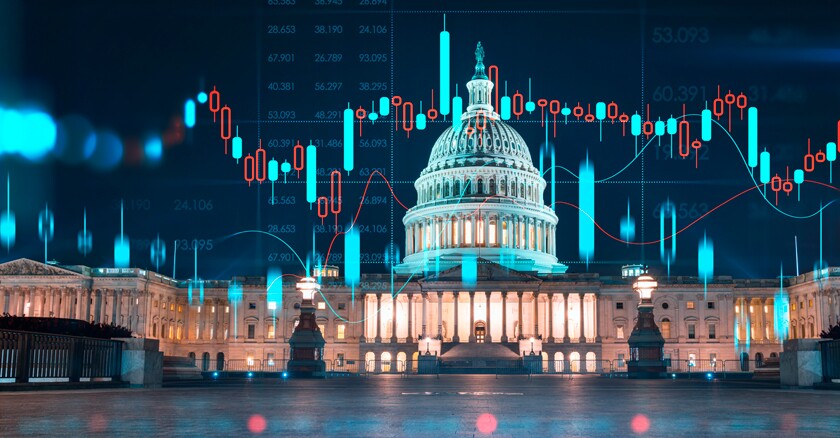When the U.S. Congress passed the Coronavirus Aid, Relief and Economic Security (CARES) Act in March 2020, it was the largest spending bill ever passed by the federal government, allocating $2.2 trillion in economic stimulus money. In December of that year, Congress broke that recently set record with a consolidated appropriations package that totaled $2.3 trillion, made up of $1.4 trillion in routine funding and $900 billion in economic stimulus. A few months later, in March 2021, Congress passed the American Rescue Plan Act (ARPA), which authorized $1.9 trillion in stimulus. And in November 2021, they passed the $1.2 trillion Infrastructure Investment and Jobs Act (IIJA).
To illustrate the scale of this spending, it is roughly equivalent to 30 percent of the gross domestic product (GDP) of the United States, a little bit over twice the GDP of India and equivalent to the combined GDP of the world’s 147 poorest countries, using the latest figures from the International Monetary Fund’s World Economic Outlook.
WHERE DID ALL OF THIS MONEY GO?
Both the CARES Act and ARPA focused heavily on coronavirus relief, and approximately $713 billion was allocated to state and local governments. As of early November 2022, more than 99 percent of that had been distributed to the relevant agencies, according to the Committee for a Responsible Federal Budget’s COVID Money Tracker.
COVID-19 relief bills included billions for transit, election security and education.
Different states have allocated different amounts of their total ARPA dollars, with some, like Minnesota, only allocating a third of its disbursed ARPA funds while others, like New York, Indiana and Montana, allocating all of theirs
These funds went to a variety of places, with the largest slices of the pie being $31.6 billion going to state operations and $28.5 billion going to infrastructure. A notable slice of $8.5 billion went to fund broadband projects. Together with the $10 billion Coronavirus Capital Projects Fund, these have funded projects in Colorado, California, Hawaii and more.
As recently as November 2022, Massachusetts earmarked $50 million in ARPA funding for broadband expansion programs facilitated by the state’s Executive Office of Housing and Economic Development and the Massachusetts Broadband Institute. These programs are in the process of selecting partner organizations from around Massachusetts to participate in long-term planning exercises and to launch local programs to boost digital literacy, Wi-Fi access and modernizing Internet access in public spaces, among other things.
Montana used ARPA funding to kickstart its ConnectMT broadband expansion program. The program is currently in the process of distributing up to $266 million in grants that will be used to deliver new high-speed broadband services to unserved and underserved communities in the state.
The state also used the funding to contract Lightbox to set up a broadband map, joining a cadre of other states this year in developing interactive broadband tools. The state has also applied some if its funding from the IIJA to the ConnectMT program.
UNPRECEDENTED FUNDING FOR CYBER
Though a fraction of overall spending, these laws authorized billions of dollars in cybersecurity, though much of it was directed toward the federal government itself. ARPA contained $1.85 billion for cybersecurity, with $1 billion going to the General Services Administration, $650 million to CISA and $200 million to the White House’s Digital Service.
But state and local governments are getting their due thanks to IIJA, which brought with it some techheavy investments, including $1 billion in grants to be awarded over the next four years to boost state, local and territorial government cybersecurity.
The 2022 grant program has ended, though it only accounts for $185 million in grants for state and local agencies and $6 million in grants for tribal governments. This money will be disbursed between state and local governments so that agencies in each state receive at least $2.19 million, with more money available for agencies in larger states. Texas and California have the largest pools of money to draw from, with $8.5 million and $8 million available to them respectively.
More money will come through this program in future years. In FY 2023, there will be $400 million in funding to the program, with $300 million in 2024 and $100 million in 2025, the program’s final year.
One of the hallmarks of the early stages of the grant program is the requirement that recipients establish a Cybersecurity Planning Committee, which might be a retooled grant management team or a new body formed in response to the program. These committees will be responsible for developing a cohesive cybersecurity plan as well as assisting other groups in coordinating cyber efforts.
WINDFALLS FOR TRANSIT AND SUSTAINABLE TECH?
There is another source of federal funding that might pique the interest of technologists in the government sector: the Inflation Reduction Act, which was signed into law in August 2022. That bill contains $369 billion aimed at funding energy security projects and addressing climate change, particularly in western states, which have been affected by ongoing drought.
The bill accomplishes this by funding or directing agencies to create more than 89 programs aimed at climate change.
The program with the most funding of these, according to a Congressional Research Service analysis of the bill, is the Greenhouse Gas Reduction Fund through the Environmental Protection Agency.
Over the next 10 years, this program will make $27 billion in grants available to states, municipalities and tribal governments to provide financing and technical assistance to low-income and disadvantaged communities to deploy zero-emission technologies.















